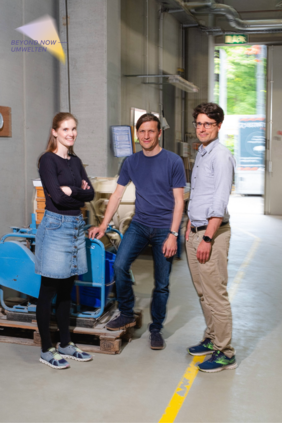
BEYOND NOW: How 3D Printing is Changing Construction
It takes just five minutes to print an artistically curved concrete vase and a few minutes for it to solidify. But what no one sees is how much work goes into designing the shape, selecting ingredients for the concrete mix, and how it takes to clean the machine after printing. »From the outside, 3D concrete printing almost looks like magic«, comments Fabian Ehle from the Junior Professorship for Mechanics of Engineering Materials. The construction industry is also expecting a real boom with the increase in digital and robot-assisted processes. The interest in construction components and even entire 3D-printed houses is enormous. Together with his interdisciplinary team, Fabian Ehle has thus launched the »Print4PR« project to demonstrate the potential uses and limitations of 3D printing in architecture and construction to address any concerns.
Up until recently,the electrical engineer who specialises in small magnetic devices and measurement technology had little contact with concrete as a building material. Since 2024, he has been part of the NanoMatFutur research group as part of the »StimuCrete« project led by Jr. Prof. Dr Luise Göbel. Together, the engineers are developing an »intelligent« concrete that can solidify in seconds through internal or external stimulation and can return to a liquid state as needed. A particularly advantageous novelty for additive manufacturing? The liquid concrete can be added one layer at a time. In order to create a wall, for example, the material must solidify immediately after being deposited from the print nozzle. The problem? Mistakes can no longer be corrected. »Flexible, adaptable concrete could reduce the amount of material used, which not only cuts costs but also reduces CO2 emissions«, explains Luise Göbel.
Sounds complicated? The researchers are convinced that in order to understand something, you have to try it out for yourself. Which is why they are now building the new »DigitalPrintCreteLab«, equipped with a 3D mortar printer, which will be available for student and scientific experiments in the future. In addition, a Bauhaus.Module on »3D concrete printing« is in the works and could begin as early as 2026. »The course is intended to provide students from all faculties with the opportunity to learn about 3D concrete printing from various starting points - creative, artistic, technical, and scientific - without any specific prior knowledge«, explains Ehle. The material concrete is also to be experienced in a sensory way through 3D-printed design objects as part of an exhibition. Hannah Friedrich, a Visuelle Kommunikation (Visual Communication) student, assisted with the design of the exhibition.
Funded by the Bauhaus-Universität Weimar as part of the »Beyond Now ⸺ Environment« annual theme and the Faculty of Civil and Environmental Engineering’s »Lighthouses@B&U« programme.
Project Participants:
Dr. Fabian Ehle, M.Sc. Timon Echt, Jr. Prof. Dr. Luise Göbel, Faculty of Civil and Environmental Engineering, Junior Professorship of Mechanics of Engineering Materials
Text: Dana Höftmann
Photos: Julian Linden
Social Media: Marit Haferkamp
Signet: Romi Klockau
Concept and Editorial: Claudia Weinreich
